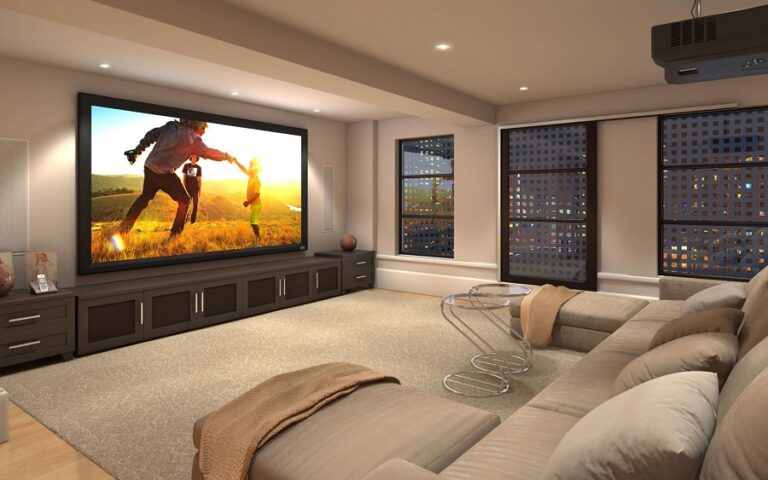
Contents
Creating the perfect home theater experience involves various components, with the projector screen playing a pivotal role. The right screen enhances image quality and transforms your viewing into an immersive experience. With many options available, from used projector screens to electric and projector screen frame kits, choosing the best one for your home theater can seem daunting. Here are some expert tips to guide you through the selection process.
1. Understand Different Screen Types
Projector screens vary widely in functionality and design, catering to different needs and spaces. Manual screens, reminiscent of traditional pull-down models, offer simplicity and cost-effectiveness, ideal for casual viewers. Electric projector screens provide a touch of luxury and convenience with remote-controlled deployment, perfect for tech-savvy users or those seeking a cleaner look. With their stable and constant presence, fixed-frame screens deliver superior picture quality for dedicated home theaters. Understanding the nuances between portable, fixed, manual, and electric options is crucial in matching a screen to your viewing habits and room requirements.
2. Consider the Screen Material
The material of your projector screen has a profound impact on image quality. Standard matte white screens distribute light evenly, ideal for controlled lighting environments, ensuring a vibrant picture. High-contrast materials excel in ambient light, offering deeper blacks and richer colors. Acoustically transparent screens, designed to let sound pass through from behind, are perfect for audiophiles with hidden speaker setups. Each material serves different viewing environments and preferences, emphasizing the importance of selecting a screen that meets your needs.
3. Size and Aspect Ratio
The size of your projector screen should harmonize with the dimensions of your home theater and your preferred viewing distance. A general guideline is that the screen width should be approximately half the distance from the screen to your seating area, optimizing visual comfort and immersion. The aspect ratio, a critical consideration, affects how content fits on your screen. A 16:9 ratio is versatile for television and most movies, while 2.35:1 caters to cinematic enthusiasts craving a widescreen experience. Balancing size and aspect ratio ensures an optimal viewing experience tailored to your favorite content.
4. Gain Factor
Gain measures a screen’s brightness when viewed from the optimal angle and is pivotal in environments where light control isn’t absolute. A higher gain amplifies brightness and suits low-lumen projectors or rooms with ambient light. However, it can narrow the effective viewing angle. Conversely, a lower gain screen supports a wider viewing angle but might require a more powerful projector. Balancing gain with your projector’s capabilities and room conditions is essential for achieving the best picture quality.
5. Viewing Angle
A wide viewing angle is paramount for home theaters accommodating diverse seating arrangements, ensuring all viewers enjoy a consistent picture quality without color shifting or brightness loss. Screens with broader viewing angles are crucial for gatherings, allowing seating flexibility without compromising visual experience. This consideration becomes even more crucial in larger rooms or spaces for social viewing, such as sports events or movie nights with friends and family.
6. Frame and Installation
The choice of a projector screen frame kit can significantly influence the aesthetics of your home theater and the overall viewing experience. Black velvet frames absorb stray light, enhancing perceived contrast and creating a more immersive viewing window. The installation process also warrants consideration; some screens offer easy DIY mounting, while others require professional installation. Opting for a screen that aligns with your room’s design and installation preferences can substantially impact setup and daily use.
7. Motorized vs. Manual
Choosing between motorized and manual screens is often convenient versus budget. Electric projector screens, with their smooth, automated operation, add a layer of sophistication and ease, especially in multi-use spaces where the screen needs to be retracted when not in use. However, manual screens can offer significant savings and simplicity for users who don’t mind a more hands-on approach. Your preference will likely depend on your budget, the frequency of use, and the desired aesthetic of your home theater.
8. Used vs. New
For those on a budget, considering a used projector screen can be a cost-effective solution. When exploring used options, it’s vital to inspect for any signs of wear, such as wrinkles or tears, that could impair image quality. A used projector screen in good condition can provide the same level of performance as a new one at a fraction of the cost, making it an excellent option for budget-conscious enthusiasts.
9. Compatibility with Your Projector
Ensuring that your chosen screen is compatible with your projector’s resolution and throw ratio is crucial for a seamless viewing experience. The screen should complement your projector’s capabilities, supporting its resolution to display crisp, clear images. Additionally, the throw ratio, which dictates the distance needed to project a certain screen size, should align with your room’s dimensions to facilitate proper placement and optimal image quality.
10. Research and Reviews
Before finalizing your purchase, dedicate time to research and reading reviews from other home theater enthusiasts. Insights on image quality, durability, ease of installation, and overall satisfaction can guide your decision-making process, helping you choose a projector screen that meets your expectations and enhances your home theater experience.
Conclusion
Choosing the best projector screen for your home theater is a decision that impacts your viewing experience. By considering factors like screen type, material, size, aspect ratio, and gain, you can select a screen that complements your projector and enhances your home theater setup. Whether you’re looking for electric projector screens, a projector screen frame kit, or a high-quality used projector screen, selecting a product that meets your specific needs is essential.
For those searching for top-notch projector screens and home theater equipment, Gearsource is your go-to online marketplace. Offering a wide selection of professional-grade audiovisual equipment, Gearsource provides everything you need to create the ultimate home theater experience. Visit Gearsource today to explore our collection and take the first step toward transforming your home viewing into a cinematic adventure.